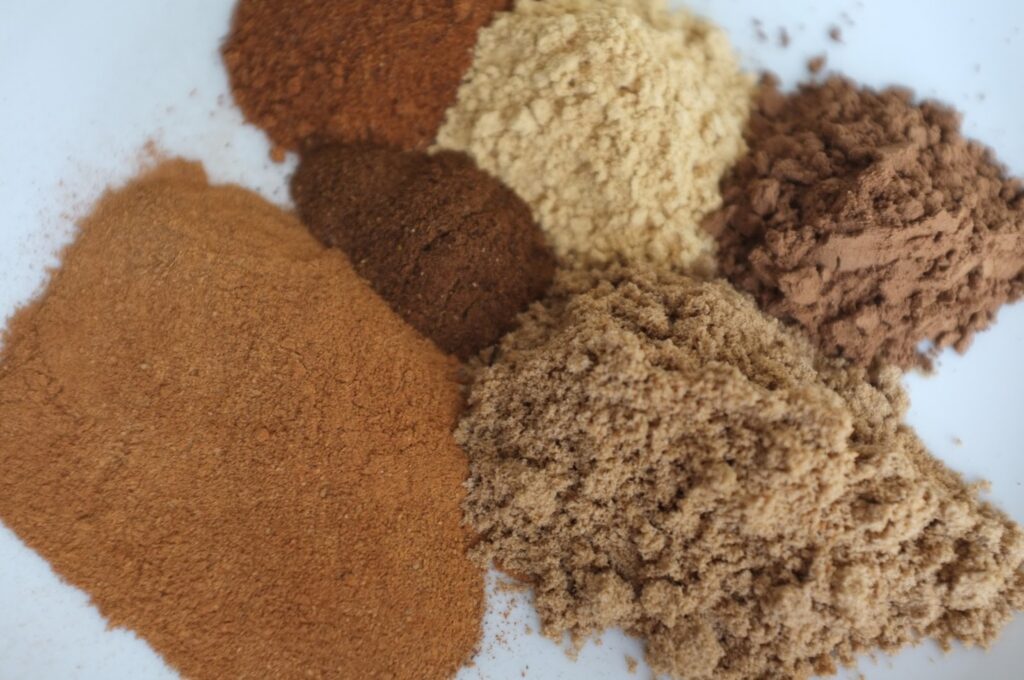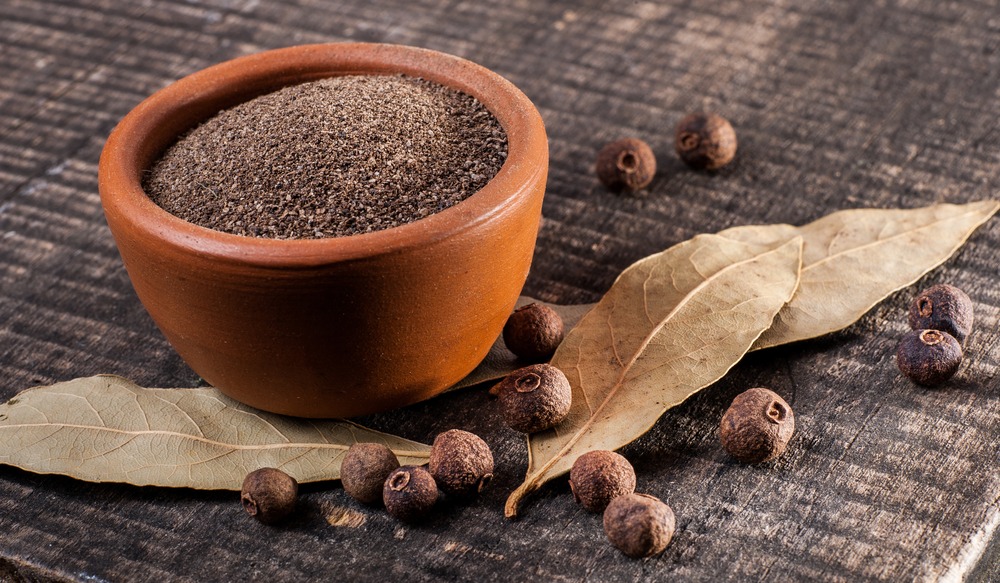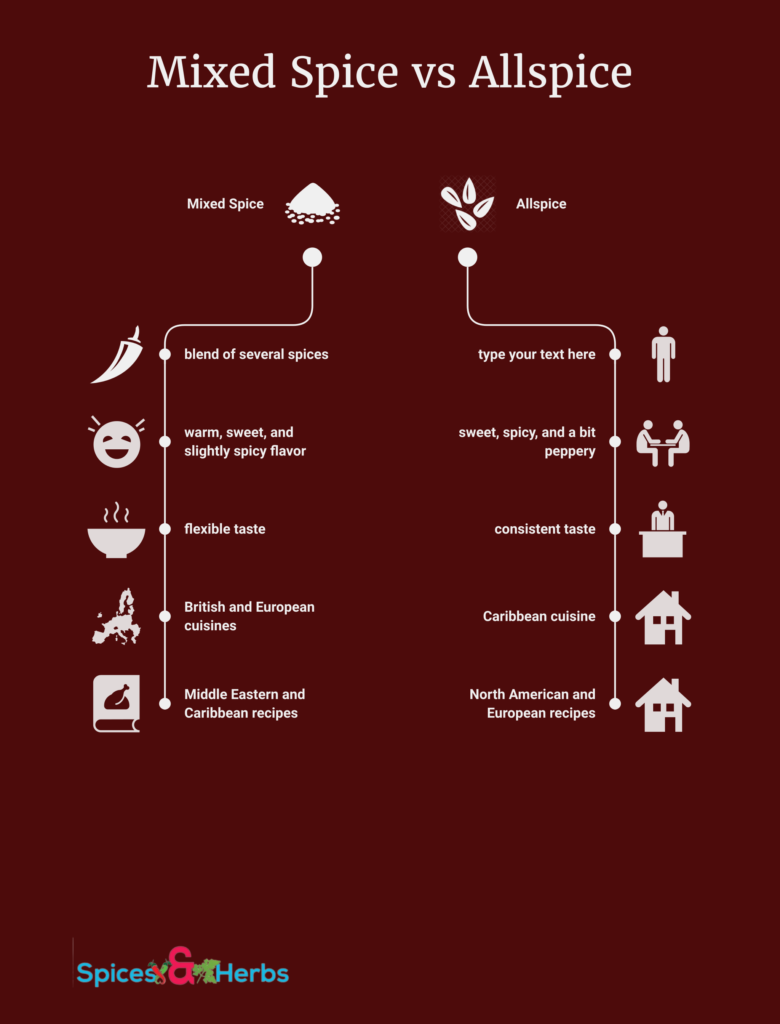Stepping into the world of culinary arts, you often come face to face with a plethora of spices, each holding its unique aroma and flavor. You’re working on a recipe that calls for ‘mixed spice,’ as you go through your spice drawer, you stumble upon ‘allspice.’ You’re left wondering, ‘What is the difference between mixed spice and allspice?’ This question isn’t just a difficulty for novice cooks. Even those with years of kitchen experience might find themselves in this perplexing situation.
This guide will demystify this spice problem, allowing you to differentiate between mixed spice and Allspice and add the perfect flavor to your dishes.
What is Mixed Spice?

As the name suggests, mixed spice is a blend of several spices commonly used in British and European cuisine. This spice mixture can be traced back to the Victorian era when it was a staple in English kitchens. The beauty of mixed spice lies in its versatility and the harmonious balance of flavors it can bring to a dish.
The spice blends typically include warm, aromatic spices such as cinnamon, nutmeg, and cloves. Some variations might also contain coriander, ginger, Allspice, and mace. Each spice contributes its unique flavor profile, creating a symphony of tastes that can elevate any dish.
🌶Common Uses of Mixed Spice in Different Cuisines
So, what is mixed spice used for? Mixed spice is a true culinary chameleon, adapting to and enhancing various mixed spice recipe. In traditional British cuisine, it’s a key ingredient in Christmas pudding and hot cross buns, imparting a distinctive festive aroma. It’s also widely used in baking, from fruitcakes to gingerbread, adding depth and warmth to sweet treats.
Beyond the British Isles, the mixed spice has found its way into Middle Eastern cuisine, adding a comforting, homey touch to savory dishes like stews and roasted meats. It’s also a secret weapon in many Caribbean recipes, lending a spicy kick to jerk seasoning.
🌶Examples of Dishes with Mixed Spice
To truly appreciate the magic of mixed spice, let’s explore some dishes where it shines. Think of a classic British apple pie, where British mixed spice melds beautifully with tart apples and a buttery crust. Or a fragrant carrot cake, where the mixed spice blend enhances the sweetness of the carrots and complements the tangy cream cheese frosting.
In savory dishes, the mixed spice can transform a simple roast chicken into a feast for the senses. A sprinkle of mixed spice and salt and pepper can create a beautiful golden crust and infuse the meat with a subtle, exotic flavor. For a vegetarian option, consider a hearty vegetable stew. Mixed spice adds complexity to the earthy flavors of root vegetables and makes the humblest ingredients taste extraordinary.
What is Allspice?

Allspice, an intriguingly named spice, is not, as its name might suggest, a blend of various spices. Instead, it is a standalone spice originating from the dried berries of the Pimenta dioica plant, native to the West Indies, Central America, and Southern Mexico.
The English coined the term ‘Allspice’ in the 17th century due to the spice’s unique flavor profile, which seems to encapsulate the essence of cinnamon, nutmeg, and cloves, all in one single berry.
These berries are usually harvested when they are green and unripe. They’re then traditionally sun-dried until they take on a brown color, resembling large, smooth peppercorns. Once dried, you can use these berries whole or ground into a fine spice powder ready for use in many culinary applications.
🌱Common Uses of Allspice in Different Cuisines
Allspice is a versatile spice that has found its way into various cuisines worldwide thanks to its multifaceted flavor profile. In Caribbean cuisine, for example, Allspice is a key ingredient in jerk seasoning, a fiery blend of spices used to marinate the meat before grilling or roasting. Similarly, Allspice is also used extensively in Middle Eastern cuisine, particularly in dishes like kibbeh and certain types of sausages.
Allspice is commonly used in sweet dishes in North America and Europe, especially during the fall and winter months. It’s a staple in spicy pumpkin pie and often added to other baked goods for a touch of warmth and complexity. Moreover, some also use it in savory dishes like stews, soups, and pickling mixtures.
🌱Examples of Dishes Where Allspice is Typically Used
To truly appreciate the versatility of Allspice, let’s explore some specific dishes where this spice shines. As mentioned, jerk chicken, a Jamaican specialty, is marinated in a mixture that heavily features Allspice. It results in a dish that is simultaneously spicy, sweet, and smoky.
In sweets, Allspice is a star player in American pumpkin pie. The warm, slightly peppery flavor of Allspice complements the sweetness of the pumpkin, creating a dessert that is synonymous with comfort and festivity.
Moving to the Middle East, Allspice is a crucial ingredient in kibbeh, a dish made of camel, goat, or lamb meat, finely ground lean beef, bulgur wheat, and minced onions . The Allspice lends an aromatic warmth to these savory meatballs, making them a beloved staple in many Middle Eastern households.
Comparing Mixed Spice and Allspice

As a parent, you understand the importance of making informed decisions, especially when feeding your family. Understanding the difference between mixed spice and Allspice can help you create dishes that are not only delicious but also cater to your family’s preferences and dietary needs.
🔁Ingredient Composition
Mixed spice is a blend of several spices, including cinnamon, nutmeg, cloves, and others like coriander, ginger, Allspice, and mace. Each spice contributes its unique flavor, creating a harmonious balance that enhances various dishes.
On the other hand, Allspice is a standalone spice derived from the dried berries of the Pimenta dioica plant. Despite its name, Allspice is not a mixture but a single spice that tastes like a combination of cinnamon, nutmeg, and cloves.
🔁Flavor Profile
Due to its diverse ingredients, mixed spice offers a warm, sweet, and slightly spicy flavor. Its taste can be adjusted based on the proportions of the spices used in the mix, providing flexibility to cater to specific taste preferences.
Allspice, conversely, has a distinctive flavor that’s simultaneously sweet, spicy, and a bit peppery. Its flavor is consistent. You can’t alter it as it’s a single spice.
🔁Culinary Uses
Mixed spice is typically common in British and European cuisines, particularly in baking sweet treats like Christmas pudding and hot cross buns. It’s also used in Middle Eastern and Caribbean recipes to add depth and warmth to savory dishes.
Allspice, however, is more prominent in Caribbean cuisine, where it’s a key ingredient in jerk seasoning. Many locals in North American and European kitchens also use this, primarily in sweet dishes like pumpkin pie and savory stews and soups.
Practical Tips for Using Mixed Spice and Allspice
Using spices like mixed spices and Allspice can help jazz up our family meals and encourage our family to develop a healthier relationship with food. But how can we effectively use these spices in cooking? Here’s some practical advice.
✅Start Small: Spices are potent; a little goes a long way. Begin with a small amount, taste test, and adjust accordingly. It is particularly important when cooking for teens, as their taste buds might be more sensitive to strong flavors.
✅Store Properly: To maintain the freshness and potency of your spices, store them in a cool, dark place, away from heat and light. Fresh spices make a difference, especially when trying to impress discerning teen palates.
✅Grind as Needed: If possible, buy whole allspice berries and grind them as needed. The flavor and aroma are much more intense compared to pre-ground Allspices. It can be an exciting kitchen activity to involve your teenagers in, teaching them about the importance of fresh ingredients.
✅Pair Wisely: Mixed spice pairs well with sweet dishes, while Allspice works well with sweet and savory recipes. Experiment with these spices in different dishes to discover what your family enjoys the most.
Suggestions for Substituting One Spice for the Other
While mixed spice and Allspice have distinct flavor profiles, they can be substituted for each other in certain recipes if necessary. However, remember that the resulting flavor will not be the same.
If a recipe calls for mixed spice and you only have Allspice, use a smaller amount of Allspice due to its stronger flavor. You can also add a dash of cinnamon or nutmeg to better mimic the taste of mixed spice.
Conversely, if you’re out of Allspice, you can use mixed spice in its place. Consider adding a bit of extra clove or cinnamon to bring it closer to the flavor profile of Allspice.
Frequently Asked Questions
Q: What can I use as a mixed spice substitute?
A: If you’re out of mixed spice, you can blend at home by combining equal parts of cinnamon, nutmeg, and cloves. If you have ginger, coriander, Allspice, and mace on hand, add these to your blend for a more complex flavor. Another option is to use pumpkin pie spice as it contains similar spices. Remember, the key is to adjust the proportions to suit your taste.
Q: Can I use mixed spice instead of Allspice in a recipe?
A: Yes, you can use mixed spice as a substitute for Allspice in a recipe, but remember that the flavor profile may change slightly. The mixed spice contains several ingredients, including cinnamon, nutmeg, and cloves, which are the flavors that Allspice resembles.
However, the mixed spice may also include other spices, such as coriander, ginger, and mace, which could alter the flavor of your dish. The substitution should work well in most recipes, but adjusting the proportions to your taste is recommended.
Q: Can these spices cause allergic reactions?
A: Yes, like any food, spices, including mixed spices and Allspice, can cause allergic reactions in some individuals. Symptoms can range from mild, such as itching and rashes, to severe, such as difficulty breathing or anaphylaxis. If you or a family member have a known food allergy or experience any adverse reactions after consuming a dish with these spices, it is important to seek immediate medical attention. Always consult your healthcare provider or a registered dietitian when introducing new foods into your diet if food allergies are a concern.
Q: Where can I purchase high-quality mixed spice and Allspice?
A: You can purchase high-quality mixed spice and Allspice from various sources. Many grocery stores carry these spices in their baking or spice section. For a wider selection of brands and origins, you could explore specialty spice stores or ethnic food markets in your area. Online retailers like Amazon offer various options, including organic and fair-trade spices. Always check the packaging for freshness and quality assurance before purchasing.
Final Words
Understanding the world of spices is like unlocking a treasure chest of flavors for your family meals. Both mixed spice and Allspice have unique characteristics that can take your cooking to new heights, enriching your dishes and your family’s dining experiences. Remember, food is not just about sustenance. It’s about exploration, learning, and connection.
Start experimenting with mixed spice and Allspice in your recipes. Try them in baking, or add a new twist to your family’s favorite stew. The possibilities are endless, as are the opportunities for creating warm, shared memories around the dining table.
We would love to hear about your mixed spice and Allspice culinary adventures. What dishes did you try? How did your family react? We love reader interactions. Sharing your experiences might inspire other parents, and together, we can create a supportive community focused on nurturing our teenagers through thoughtful, flavorful cooking. So, don’t hesitate to leave a comment below. Let’s embark on this flavorful journey together.

